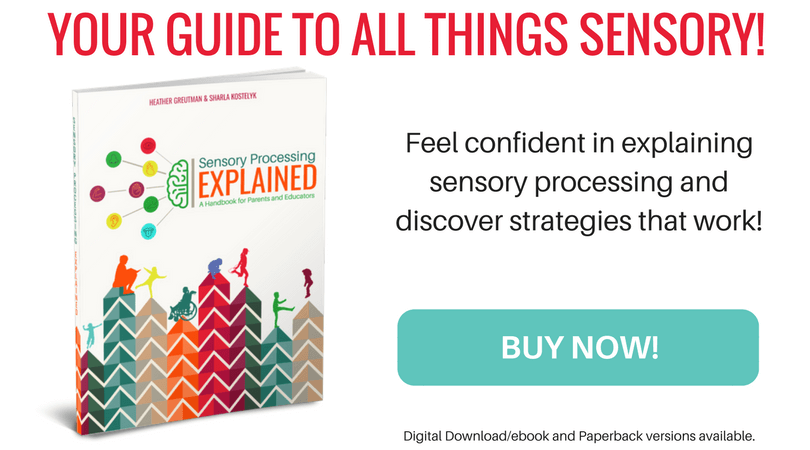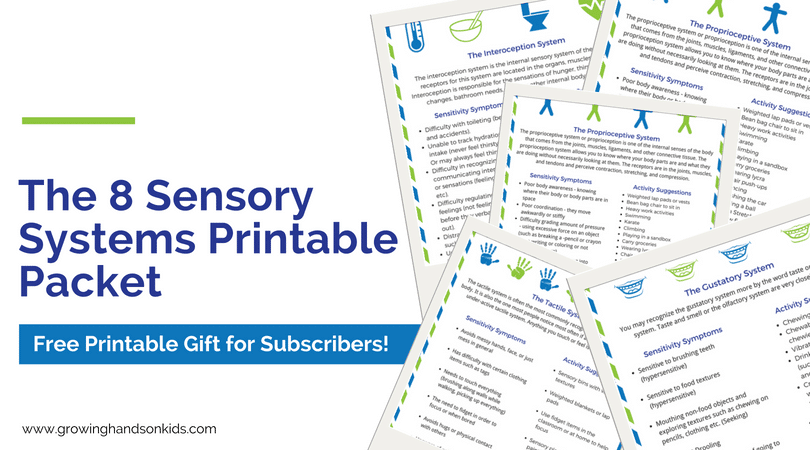The Best Activities for the Tactile System
Affiliate and Referral links are used below to promote products I love and recommend. I receive a commission on any purchases made through these links. Please see my disclosure policy for more details. As an Amazon Associate, I earn from qualifying purchases.
The tactile system is often the most commonly recognized sensory system of the body. It is also the one people notice most often if a child has an overactive or under-active tactile system. Anything you touch or feel is part of this system. Today I want to share some of the best activities for the tactile system. These will be especially helpful if your child is over-sensitive or under-responsive to tactile input.
What is the Tactile System?
The tactile system is also known as the sense of touch. The input from this system comes from the skin. The sensory receptors in our skin send messages to our central nervous system so that we are able to process and interpret this incoming information. This includes temperature, texture, pain, pressure, and traction. Is the item safe to touch? What does it feel like?
Keep in mind that Touch can fall under protective or discriminatory categories of sensations. Protective sensations allow you to realize when something is sharp or hot and not to touch it. Discriminatory sensations allow you to tell the difference between objects based on how they feel. This includes being able to reach into a bag and find your phone based solely on how it feels. Your past tactile sensory experiences allow your brain to figure out what you are feeling without seeing it.
Symptoms of Tactile Sensitivities
Symptoms of tactile sensitivity (hyper, hypo, and under-responsive) include:
- avoids messy hands, face, or just mess in general
- has difficulty with certain clothing items such as tags
- needs to touch everything (brushing along walls while walking, picking up everything)
- the need to fidget in order to focus or when bored
- avoids hugs or physical contact with others
- unaware of pain or if hands or face are messy
- may crave being close to people or need to be touching something constantly
- seem unaware of dangerous items that may cause pain or injury
- may be unaware if something hurts (high pain threshold)
Activities for the Tactile System
There are many other activities you can do, but these are some of my favorite.
|| Sensory Bins with Various Textures
Sensory bins are a great way to introduce children to a variety of textures in a fun way. Here are some of my favorite sensory bins.
Spring & Summer Sensory Bins from Teaching Mama
Insect Sensory Bin from Teaching Mama
100+ Sensory Bin Ideas from The Chaos And The Clutter
|| Use a Weighted Blanket or Lap Pad
You can read all about weighted blankets in this post from my friend Cara, an Occupational Therapist. I also have a DIY Lap Pad tutorial here.
|| Play with Playdough or Finger Painting
You can make your own calming no-cook play dough recipe or finger paint! If your child struggles with touching the finger paint, put it inside a plastic bag and tape it shut. You can find more details on this activity by clicking here to this Tummy Time Finger Paint Sensory Play post from CanDo Kiddo. This post talks about using it with babies, but any child can benefit from tummy time while finger painting this way.
|| Deep Pressure
Proprioception is another one of the 8 senses that is closely connected to the tactile system. Deep pressure either by rolling an exercise ball across the back or squeezing the hands can help get this input and help to desensitize the tactile system.
|| Using a Stress Ball
Stress balls are a great way to get some additional tactile input and also make great fidget tools.
|| Shaving Cream Finger Paint
This was one of my favorites to use while I was working in the schools and with my own children. They can write their names, copy shapes or letters/numbers. The possibilities are endless with this one.
|| Play in the Mud
I know, we all may be cringing at this one. But get out some clothes you don't mind getting dirty and just have fun playing in the mud. You can also create these mud sensory bins.
|| Make Slime
Slime is all the rage right now. You can buy a kit or make your own slime. I also shared some fun ways to play with slime here. Another borax free option is to make oobleck (cornstarch and water combo).
|| Play with Water Beads
You can use regular water beads or make your own with tapioca pearls.
|| Play with Kinetic Sand
You can buy it already made with fun kits, or you can make your own kinetic sand very easily. Here are some fun ways to play with kinetic sand.
|| Make Cloud/Moon Dough
Here's a great recipe for cloud/moon dough that you can make different colors.
|| Jump into a Pile of Leaves
If you don't have all 4 seasons where you live, you can come up with other types of piles to jump into. A ball pit or gymnastic foam pit are great options.
|| Gardening (planting flowers, vegetables, digging in the dirt)
My two children loved helping to plant our garden this year. We used raised beds for our vegetable garden, but they also help me weed the flower beds and plant flowers.
|| Cooking or Baking
Both of my children enjoy helping me in the kitchen. My son who is 4 helps wash potatoes and is learning to crack eggs. My daughter made oatmeal cookies the other day with grandma's limited help. Get in the kitchen and have fun!
Is your child struggling with tactile sensory input? Talk to your doctor and also pick up a copy of our book, Sensory Processing Explained. We go into great detail about the tactile system, how it affects behavior, and give you even more practical ideas to address tactile sensitivities at home and in the classroom.
You can also learn more about all 8 sensory systems by signing up for my free email series below and get a copy of my 8 sensory systems printable packet for free.

Heather Greutman, COTA
Heather Greutman is a Certified Occupational Therapy Assistant with experience in school-based OT services for preschool through high school. She uses her background to share child development tips, tools, and strategies for parents, educators, and therapists. She is the author of many ebooks including The Basics of Fine Motor Skills, and Basics of Pre-Writing Skills, and co-author of Sensory Processing Explained: A Handbook for Parents and Educators.




